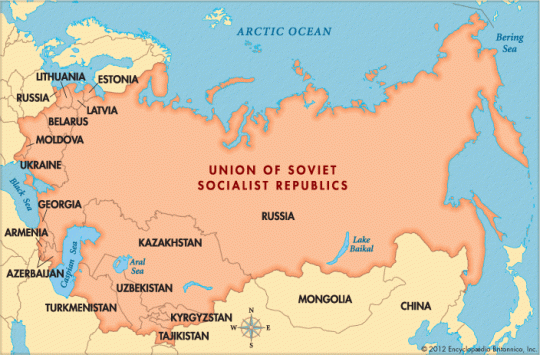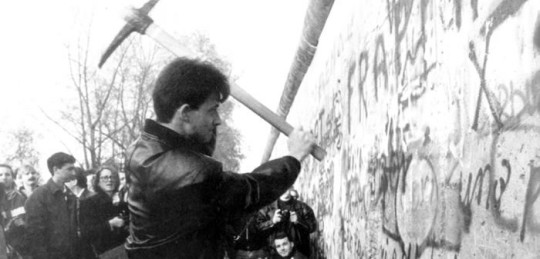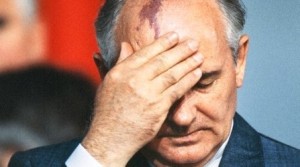Gorbachev’s Miscalculation and the Collapse of the Soviet Union
Soviet capitulation occurred because Gorbachev profoundly miscalculated how integral the Red Army was to maintaining the communist order within Eastern Europe and the USSR itself. The slightest reform would lead to complete collapse.
Mikhail Gorbachev came to power in the Soviet Union with the intention of transforming the Soviet economy and easing Cold War tensions. He realized the USSR could no longer compete with the United States in the Cold War arms race as its economy was far weaker than that of its rival. To transform the Soviet economy Gorbachev instituted economic and political reforms known perestroika and glasnost. Although Gorbachev did not intend for these policies to lead to the demise of the Soviet Union as a superpower, they inevitably did. This marked the conclusion of the Cold War and transformed the world’s balance of power.
Unacceptably overtaxed by Cold War confrontation
By the mid 1980s, the United States was spending approximately 6 percent of its 5 trillion dollar Gross National Product (GNP) on defense while the Soviet Union’s defense spending was roughly a quarter of its 1.4 trillion dollar GNP. It had become clear to Gorbachev by May of 1985 that the USSR was no longer able to compete with the west economically, and the Soviet economy had been “unacceptably overtaxed by cold war confrontation.” Furthermore Gorbachev was well-aware that the Soviet Union could not compete with Ronald Reagan’s Strategic Defense Initiative or ‘star wars’ program. Gorbachev’s intent was to reform the USSR’s economic and political structures and bring a détente to Cold War tensions through his policies of perestroika and glasnost.
Both perestroika and glasnost were policies implemented by Gorbachev to boost the Soviet economy. Perestroika (restructuring) was an economic reform policy involving the decentralization of the economy. Furthermore Gorbachev proposed that the Soviet satellite states of the Eastern European Bloc accept financial autonomy. This would relieve Moscow of its subsidy relationship with its Warsaw Pact neighbors, and allow these states to become self-sufficient.
Going hand in hand with the economic reforms of perestroika was glasnost (openness), Gorbachev’s liberalizing political policy. This policy allowed more sensitive aspects of Soviet history to be reconsidered and discussed. In February of 1987 Gorbachev released many political prisoners and called for the blank pages of Soviet history to be filled in. He also renounced the Brezhnev Doctrine meaning the Kremlin would no longer intervene militarily in the Eastern Bloc’s internal affairs. This was closely related with the plan that these states would become economically self-sufficient. Glasnost was the cornerstone of alleviating Cold War tensions and thus reducing Soviet military spending by creating a international reputation of Gorbachev as that of a liberal.
The USSR would remain a “counterweight to Washington”
Gorbachev intended to bring an end to Cold War tensions in order to alleviate inflated Soviet defense spending. However he intended to preserve “two distinct social systems, one capitalist and one socialist.” In April of 1986 Gorbachev pledged “that the Soviet Union and the socialist camp would continue to serve as a ‘counterweight’ to Washington.” This demonstrates that Gorbachev never intended for there to be a change in the bipolar world order, he intended simply for a détente in Cold War tensions.
But the Red Army was what kept Eastern Europe communist
Gorbachev believed by implementing perestroika and glasnost the USSR could allow the Warsaw Pact states to operate autonomously, without the threat of Soviet military intervention, however they would remain allied partners. This policy was unique amongst USSR leaders. Leonid Brezhnev’s policy towards the Eastern European Bloc, known as the ‘Brezhnev Doctrine,’ forbade any democratization or economic integration with the West amongst Warsaw Pact states, with the threat of military force. Joseph Stalin was equally intent on maintaining the Eastern Bloc as Soviet satellite states through the threat of force. However brutal these policies may be, they were actually the “cornerstone of the East Bloc’s stability.” Gorbachev’s “profound miscalculation was . . . a complete failure ‘to come to terms with the depth of popular East European disillusionment with and opposition to any form of communism, reformed or otherwise.’” The very reason that Eastern Europe remained communist and in the Soviet sphere of influence was with the threat of the Red Army.
The Berlin Wall falls – the symbolic end of communism in Europe
The combination of Hungarian reforms which occurred before Gorbachev’s rule and Gorbachev’s reform policies led to Hungarian democratization. Hungarian reform led to East German reform and German reunification, a symbolic end for communism in Eastern Europe. In September of 1989 Hungary opened its borders with Austria, this allowed East Germans to travel through Austria into West Germany. Eleven thousand East Germans did just that, fleeing communist rule. East Germans proved there was a very strong anti-communist feeling as thousands took to the streets to show their dissent. This movement culminated in the collapse of the Berlin wall on the 9th of November, 1989. As well as symbolizing the collapse of communism in Eastern Europe this event led to the reunification of Germany. The West German population enjoyed a much higher living standard than that of the East, and therefore East Germany was willing to join West German governance. The East German thinking allowed the Chancellor of West Germany, Helmut Kohl, to reunify Germany under Western conditions. This meant a reunified Germany would join NATO and the European Community. Gorbachev planned on allowing cooperation between Europe’s capitalist and communist camps, but did not anticipate East Germany to join the capitalist camp outright.
Gorbachev’s policies ended communism in Europe, and reunited Europe as well as Germany. This caused President George H.W. Bush to proclaim that the Cold War was over in a November 1990 speech in Paris. Each of the former Warsaw Pact states subsequently democratized. Economically the East Bloc also reformed. “In December 1989 the EU took the initiative to create a European Bank for Reconstruction and Development . . . which provided loans to and encouraged capital investment in the Eastern European countries to facilitate their transition to market economies.” This paved the way for the Czech Republic, Estonia, Poland Hungary, Slovenia, Latvia, and Lithuania to join the EU in 2004, and Bulgaria and Romania to join in 2007. Many former Warsaw Pact states would also join NATO, marking their divorce from Russia.
The USSR’s makeup
The collapse of communism in Eastern Europe was caused by Gorbachev’s policies of perestroika and glasnost. However the Soviet Union itself was still intact, and still held a degree of international power. To understand the process in which the Soviet Union fell apart, one must first understand the history and geography of its makeup. From 1939 to 1940 the Soviets annexed the Baltic states, today’s Ukraine and Belarus, and eastern Poland. Then, with the conclusion of the Second World War, they imposed the Soviet system on the formerly independent states of Eastern Europe, which became the Eastern Bloc of Soviet satellite states. Thus, the loss of Eastern Europe from the Soviet sphere inspired the next tier of ethnically distinct nations annexed by Russian conquest to push for independence.
 The Soviet Union itself was a huge federation made up of many republics. At the center of this federation stood the enormous Russian Republic. On its west was were the other Slavic republics of the Ukraine and Byelrussia, as well as Moldavia. To the north of these were the Baltic republics of Estonia, Latvia, and Lithuania. The Caucasus region contained the three republic of Georgia, Armenia, and Azerbaijan. Finally, the central Asian region of the USSR contained the republics of Kazakhstan, Uzbekistan, Turkmenistan, Kirghizia, and Turkmenistan. These fifteen were brought together by the common identity of being within the Soviet Union, but were “different in every other respect: power, size, living standard, language, religion, birth-rate, history, and culture.” As Eastern Europe fell from Soviet control, these nations too began to feel inspired by the liberating atmosphere of Gorbachev’s perestroika and glasnost.
The Soviet Union itself was a huge federation made up of many republics. At the center of this federation stood the enormous Russian Republic. On its west was were the other Slavic republics of the Ukraine and Byelrussia, as well as Moldavia. To the north of these were the Baltic republics of Estonia, Latvia, and Lithuania. The Caucasus region contained the three republic of Georgia, Armenia, and Azerbaijan. Finally, the central Asian region of the USSR contained the republics of Kazakhstan, Uzbekistan, Turkmenistan, Kirghizia, and Turkmenistan. These fifteen were brought together by the common identity of being within the Soviet Union, but were “different in every other respect: power, size, living standard, language, religion, birth-rate, history, and culture.” As Eastern Europe fell from Soviet control, these nations too began to feel inspired by the liberating atmosphere of Gorbachev’s perestroika and glasnost.
Caught in a cycle of reform
Despite perestroika the Russian economy remained abysmal. By 1989 the budget deficit reached 14 percent of GNP. This represented the failure of Gorbachev’s perestroika. Political unrest due to the weak Soviet economy and the failure of perestroika caused Gorbachev to undertake a new “political perestroika.” At the same time the collapse of communism in Eastern Europe was now causing a “violent awakening of the nationalities [which] was dissolving the Union.” To save his position, Gorbachev had only one recourse: to further reform and give the Soviet Union a presidential regime, an element of his new political perestroika. Gorbachev was caught in a cycle, his reform policies caused unrest, to react he enacted more reforms, which in turn caused more unrest.
The USSR’s new presidential regime required a degree of democratization, as many political positions “from the Secretaries of Party cells to First Secretaries of Republics all leaders would have to be elected.” On the 14th of March of 1989, Gorbachev was elected President by the Soviet Congress. However in 1990 the Soviet economic problems continued to mount and in 1991 the republics continued to push for autonomy. Gorbachev again attempting to reform the Soviet system to regain stability, he attempted to “get popular backing for a new federation based on democratic principles,” and put a referendum to the people on the 17th of March 1991. Gorbachev did not realize his communism was the unifying force of the USSR, without communist ideology, the people of the Soviet republic turned to nationalism. Although Gorbachev attempted to add legitimacy to his rule through a referendum, six Soviet republics – “Armenia, Georgia, Moldavia, Latvia, Lithuania, and Estonia – did not take part as they had no intention of being part of a renewed federation.” Gorbachev’s referendum gave the republics an opportunity to reject the Kremlin’s rule.
The Union disintegrates
Gorbachev’s glasnost policy also contributed to the break up of the USSR. It allowed people to discuss and question topics such as the legality of the Baltic annexation in the 1940 Soviet – Nazi non-aggression pact, influencing independence movements in these areas. Once the population was able to question the legality of their annexation, they questioned their republic’s status a region within the USSR. Glasnost fuelled nationalist views as the populations of the USSR’s fifteen republics began to resent Soviet rule. In February of 1990 there were ethnic riots in Tajikistan and Uzbekistan. In December of 1989 the Lithuanian Communist Party had already declared itself independent from the Soviet government. Despite warnings from Moscow that this action was illegal, on the 11th of March 1990, the Lithuanian Parliament declared independence. This triggered the Estonian and Latvian parliaments to declare independence from the Soviet Union on the 3rd of April and 4th of May respectively. After these little republics declared independence, the two largest, the Ukraine and Russia, proclaimed their sovereignty – Russia on the 12th of June and the Ukraine on the 16th of July. In Armenia, there were the beginnings of civil war. The Soviet Union had fallen into internal disarray.
The end of the Cold War arms race and the bipolar global order
Most of the Soviet defence infrastructure was located in the new republics of Russia and the Ukraine. Once they declared independence the leaders of these newly created states severely slashed defence production. “United States intelligence reports estimated that Russian military procurement for the first quarter of 1992 was cut by a whopping 80 percent . . . other indications are that procurement was down 50 percent.” Either way these defence cuts meant the Cold War arms race was over. Gorbachev intended for the USSR to remain a superpower, but by 1992 the bipolar world order no longer existed. This change in the world’s balance of power became especially evident with the 1990s NATO mission in Yugoslavia, an area of former Soviet control. The fact that NATO was able to operate in Russia’s former sphere of influence displayed the complete loss of international political and military power that Russia suffered due to the disintegration of the Soviet Union.
The collapse of the USSR caused Gorbachev to resign as President of the Soviet Union on the 25th of December, 1991. His successor, Boris Yeltsin took steps to adopt a fully functioning market economy. This went beyond Gorbachev’s economic reform policy of perestroika, it meant Russia was no longer communist. This marked the collapse of communism, the end of the Cold War, and the beginning of the modern unipolar world order. Gorbachev’s reform policies set in motion a series of events which would result in a revolution in the international balance of power, however this was never Gorbachev’s intention.
Works Cited
Barany, Zoltan and Ivan Volgyes. The Legacies of Communism in Eastern Europe. Baltimore: The John Hopkins University Press, 1995.
Braun, Aurel. The Soviet-East European Relationship in the Gorbachev Era: The Prospects for Adaptation. Boulder: Westview Press, 1990.
Dobell, Peter. The Changing Soviet Union: Implications for Canada and the World. Toronto: James Lorimer and Company, 1991.
Garthoff, Raymond L. “Why Did the Cold War Arise, Why Did It End?”, in Michael J. Hogan. The End of the Cold War: Its Meaning and Implications. Cambridge: Cambridge University Press, 1992.
Gedmin, Jeffrey. “Helmut Kohl, Giant: His Cold War, His Germany, His Europe.” Policy Review, No. 96. August 1, 1999.
http://www.hoover.org/publications/policy-review/article/6283
Gedmin, Jeffrey. The Hidden Hand: Gorbachev and the Collapse of East Germany. Washington D.C.: The AEI Press, 1992.
Goodby, James E. Europe Undivided: The New Logic of Peace in U.S. – Russian Relations. Washington D.C.: United States Institute of Peace Press, 1998.
Grachev, Andrei S. Final Days: The Inside of the Collapse of the Soviet Union. Boulder: Westview Press, 1995.
Hogan, Michael J. The End of the Cold War: Its Meanings and Implications. Cambridge: Cambridge University Press, 1992.
Keylor, William R. A World of Nations: The International Order Since 1945. New York: Oxford University Press, 2009.
Kraljic, Michael A. The Breakup of Communism. New York: The H.W. Wilson Company, 1993.
Lesourne, Jacques and Bernard Lecomte. After Communism: From the Atlantic to the Urals. Berkshire: Harwood Academic Publishers, 1991.
Lynn-Jones, Sean M. The Cold War and After: Prospects for Peace. Cambridge: The MIT Press, 1992.
Urban, G. R. End of Empire: The Demise of the Soviet Union. Washington D.C.: The American University Press, 1993.
Reynolds, David. “Beyond Bipolarity in Space and Time”, in Michael J. Hogan. The End of the Cold War: Its Meaning and Implications. Cambridge: Cambridge University Press, 1992.
Sandle, Mark. Gorbachev: Man of the Twentieth Centurey? London: Hodder Education, 2008.
Stokes, Gale. The Walls Came Tumbling Down: The Collapse of Communism in Eastern Europe. New York: Oxford University Press, 1993.
Szporluk, Roman. Russia, Ukraine, and the Breakup of the Soviet Union. Stanford: Stanford University Press, 2000.


